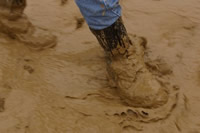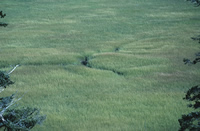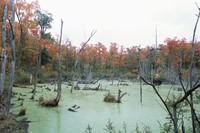There is Something in the Water
Standards
Concepts

The United States is losing 60,000 acres of wetlands each year. Is this good or bad? Does anyone really want to live in swamps, fens, bogs, and marshes? Or is it better economics to drain the wetlands for other purposes like agricultural development? In this lesson students will learn about this monumental issue facing the United States while viewing it from an economic perspective.
Introduction
 Gross! You just stepped into what looked like a perfectly solid piece of ground, and you were rewarded by getting your new shoes sopping wet and muddy. What is it you just stepped in? Chances are you dirtied your new shoes by coming across a fen, a very distinctive type of wetland. Wetlands are located all over the world and in every state of the United States. Although a wetland may have soiled your shoes, chances are you have received many benefits from wetlands, perhaps without knowing about it. This lesson will take you on a journey of discovery into an issue that is now the subject of debate throughout the country: The loss of our wetlands and the economics behind it.
Gross! You just stepped into what looked like a perfectly solid piece of ground, and you were rewarded by getting your new shoes sopping wet and muddy. What is it you just stepped in? Chances are you dirtied your new shoes by coming across a fen, a very distinctive type of wetland. Wetlands are located all over the world and in every state of the United States. Although a wetland may have soiled your shoes, chances are you have received many benefits from wetlands, perhaps without knowing about it. This lesson will take you on a journey of discovery into an issue that is now the subject of debate throughout the country: The loss of our wetlands and the economics behind it.
Note to teachers: If your students have not been introduced to the concepts of scarcity, decision making, and opportunity cost, you may want to consider using some other lessons in preparation for this one.
Learning Objectives
- Analyze and debate the tradeoffs between increasing arable farmland and making other development ventures through draining/filling wetlands as opposed to retaining the wetlands’ value as a natural resource.
- Discuss the economic factors involved in making decisions about draining wetlands versus protecting them to retain their value as a natural resource.
- Describe how cost/benefit analysis applies to wetlands issues.
Resource List
- EPA What are Wetlands?: This is the United States Environmental Protection Agency website. This page offers a broad overview of wetlands.
https://www.epa.gov/wetlands/what-wetland - EPA Economic Benefits of Wetlands: This is the United States Environmental Protection Agency website. This page gives many examples of the economic benefits wetlands provide.
https://www.epa.gov/wetlands
- EPA Wetland Types: This is the United States Environmental Protection Agency website. This page provides details about specific types of wetlands.
https://www.epa.gov/wetlands/classification-and-types-wetlands#marshes - Sackett v. Environmental Protection Agency Supreme Court 2023 ruling that established a more stringent test to determine whether the Clean Water Act applies to a wetland. https://apnews.com/article/wetlands-business-climate-and-environment-washington-news-41fc297006512e1f507dc12daa44824a
- Eastern South Dakota Wetlands: This site will convey the history behind the wetlands debate in South Dakota.
https://www.fws.gov/wetlands/Documents/Eastern-South-Dakota-Wetlands.pdf - Louisiana Coastal Wetlands: A Resource at Risk: Have the students use this site for help in completing the extension activity.
- Katrina, Rita Actually Helped Wetlands, Study Says: This National Geographic article provides in-depth information about the Louisiana wetlands as they existed almost a year before Katrina hit New Orleans.
https://web.archive.org/web/20100310190127/http://news.nationalgeographic.com/news/2006/09/060921-wetlands_2.html
Process
Start the lesson by asking the students if they have ever seen an area of land that seems totally inhospitable–perhaps a desert, a mountain top, or some sort of wetland. Give them time to answer: then ask if they would be sorry if that piece of land were to be developed. What if an ugly swamp that is now a breeding ground for mosquitoes could be turned into a water park, golf course, or fertile farmland? All of these uses of the land might help the local economy far more than a dank old swamp or desert. Or could they?
 Since this lesson focuses on wetlands have the students visit the EPA’s wetlands overview site: https://www.epa.gov/wetlands/what-wetland
Since this lesson focuses on wetlands have the students visit the EPA’s wetlands overview site: https://www.epa.gov/wetlands/what-wetland
After the students have read the information at this Web site, guide a brainstorm session focusing on economic benefits that wetlands create.
Optional: Students may find that learning about different types of wetlands could be beneficial. Have the students view the https://www.epa.gov/wetlands/classification-and-types-wetlands#marshes page to learn about the different types of wetlands.
Wetlands do more for society than we tend to think. They act as a natural water filter, preventing pollution from entering more accessible bodies of water. Wetlands are nature’s first line of defense against floods. They act as giant sponges, decreasing the severity of floods. For more information about the economic benefits of wetlands, have the students visit the EPA Economic Benefits of Wetlands page.
 Of the economic benefits wetlands offer, many are unseen and recently discovered. But what if the value of development outweighs the value of the wetlands? In Sackett vs. EPA the Supreme Court Thur sharply limited the federal government’s authority to police water pollution into certain wetlands, the second decision in as many years in which the court narrowed the reach of environmental regulations. Have students read about the decision here The outcome could threaten efforts to control flooding on the Mississippi River and protect the Chesapeake Bay, among many projects. Environmental advocates said the decision would strip protections from tens of millions of acres of wetlands.
Of the economic benefits wetlands offer, many are unseen and recently discovered. But what if the value of development outweighs the value of the wetlands? In Sackett vs. EPA the Supreme Court Thur sharply limited the federal government’s authority to police water pollution into certain wetlands, the second decision in as many years in which the court narrowed the reach of environmental regulations. Have students read about the decision here The outcome could threaten efforts to control flooding on the Mississippi River and protect the Chesapeake Bay, among many projects. Environmental advocates said the decision would strip protections from tens of millions of acres of wetlands.
Some people in South Dakota are having problems with developing their wetlands for farming. Read about the Eastern South Dakota Wetlands
Students will now have an introduction to the economic arguments for both sides. Tell the students to make a choice on the scarcity of the resources available.
Lead a discussion with the class by asking what they think should be done. If the class sides with the wetlands and believes development can be bypassed play the part of devil’s advocate and argue for development. If the students side with development over keeping the wetlands make sure you argue for the wetlands. The goal of this discussion is to transmit every option to the students and give them some basis for their choices.
Conclusion
Did you learn something about the hard choices and painful decisions involved with the wetlands? Natural resources may seem abundant, but that is not always the case. Future generations will suffer from poor management of these resources. Mindful trade-offs and good management are essential for maintaining and preserving these resources as long as possible. But when a choice has to made, you will be prepared to make an educated and responsible one.
Extension Activity
The tragedy of hurricane Katrina has taken a major toll on the people of Louisiana and many other Gulf Coast states. When the flood waters abate and damage can be properly assessed, what effect do you think Katrina will on the vital wetlands of the region? Write a short position paper using the ideas and information you have studied in this lesson. In discussing Katrina’s effects on surrounding wetlands, be sure to discuss the economic effects that will follow from any damage done.
Have the students use the following Web sites as resources for their papers:
Louisiana Coastal Wetlands: A Resource at Risk
This National Geographic article provides in-depth information about the Louisiana wetlands as they existed almost a year before Katrina hit New Orleans.
Assessment
- Why is there a controversy surrounding wetlands?
[Wetlands offer economic benefits to society, however these economic benefits are hard to capture in monetary terms by individuals.] - What choices concerning the wetlands did you make?
[Answers will vary.] - What information did you need to make those choices?
[Answers will vary.] - What trade-offs did you make?
[Answers will vary.] - Describe the cost/benefit analysis of restoring wetlands versus draining them.
[Answers will vary. Students should examine the costs of keeping the wetlands and foregoing industrial or commercial development. They should be privy to the unseen costs and benefits keeping the wetlands.]